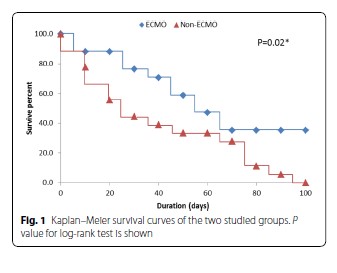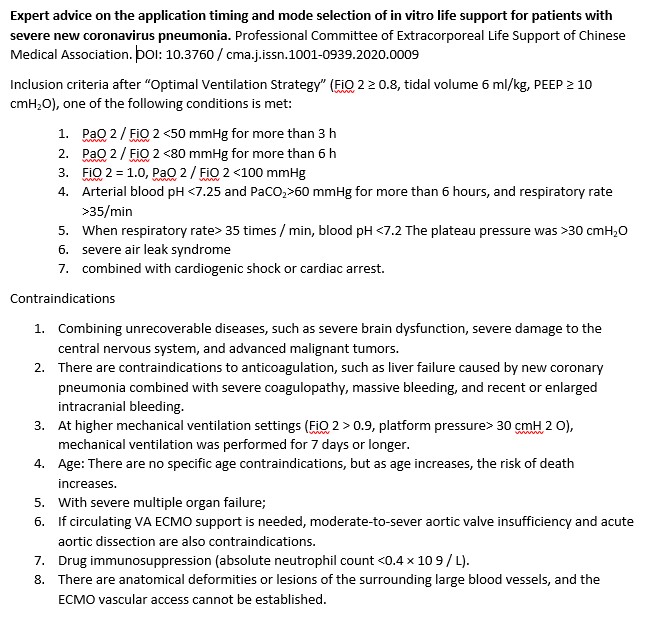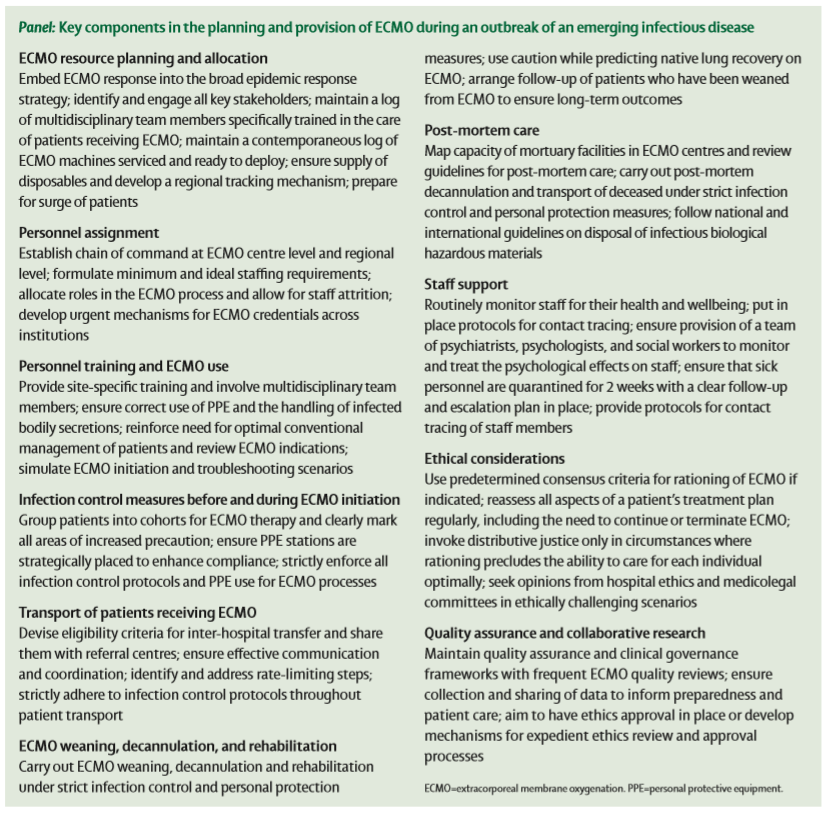Dr. William Teeter
Introduction
COVID-19 infection has now been confirmed in hundreds of thousands of people worldwide. Early reports suggested that 15-30% of patients develop ARDS1. In two studies from Wuhan, China, 11.1% and 11.5% of patients requiring ICU care required ECMO2,3, but other series show rates as low as 1% and as high as 15%.4,5 The World Health Organization has recommended “In settings with access to expertise in extracorporeal membrane oxygenation (ECMO), consider referral of patients with refractory hypoxemia despite lung protective ventilation.”6 They stress that ECMO should only be offered at centers experienced in its use. Further the Society for Critical Care Medicine recommends against the initiation of new ECMO centers for the treatment of COVID-19. An opinion piece in JAMA summarized this sentiment well, “ECMO is not a therapy to be rushed to the front line when all resources are stretched in a pandemic.”1
ARDS following Coronavirus Infection
Overall, the data for ECMO’s use in COVID is of poor quality given the novelty of the disease. Previous data from the MERS-CoV epidemic showed favorable results for patients who received ECMO. In a retrospective cohort study of group of patients 35 patients with MERS-CoV and refractory hypoxemia, those who received VV ECMO had lower in-hospital mortality, the (65 vs. 100%, p = 0.02)(Figure 1)7

COVID-specific data is still sparse and preliminary. A small series of 5 COVID19 patients receiving ECMO is available online. Of these patients, 4 were male with a mean age of 55.6 years [range 44-68] and a mean duration of 9.25 days on ECMO. They summarize their experience and make several experience based recommendations which largely mirror current practice. (Figure 2. Adapted from powerpoint available online)8

Of the peer-reviewed research, there is a paucity of data with poor communication of the ECMO specific outcomes, likely due in large part that many patients may still be on ECMO at the time of publications. (Table 1).
32250385
| Yin9 | Guan10 | Huang5 | Grasselli4 | Yang3 | Wang2 | |
| All patients | — | 1099 | 41 | — | — | 138 |
| ICU | 112 (100%) | 55 (5%) | 13 (32%) | 1591 (100%) | 52 (100%) | 66 (35%) |
| ARDS | 101 (90%) | 37 (67%) | 11 (85%) | ~66% | 35 (67%) | 27 (20%) |
| Age, y | 66 | 47 | 49 | 63 | 60 | 66 |
| Died | 15 (14%) | 55; 1029 remain admitted | 7 (54%) | 405 (26%); 920 still in ICU | 20 (39%) | 6 (4.3); 61.6% still in ICU |
| ECMO | 14 (13%) | 5 (9%) | 2 (15%) | 5 (1%) | 6 (11.5%) | 4 (11.1) |
| ECMO outcome | 5 died, 3 still on | Unknown | Unknown | Unknown | Unknown | Unknown |
Co-opting the available data for ARDS in general has led other societies to generate guidelines for the use of ECMO in COVID-19.11 The EOLIA trial was the most recent trial to examine the use of ECMO in ARDS, but was stopped early due to futility.12 Using a Bayesian approach, Goligher et al provided a supplementary analysis which suggested lower mortality with ECMO in severe ARDS.13 However, a systematic review of 429 patient in two trials showed a reduced 60-day mortality with ECMO (RR 0.73, 95% CI 0.58–0.92). While these studies offer some evidence for ECMO in ARDS, they did not include COVID-19 patients, but represent the only high quality data available for guiding our treatment of them.
Overall, the literature on COVID-19 specific use of ECMO is sparse . While previous experience with SARS, MERS, and ARDS in general can help guide clinicians, there is no definitive conclusions about changes in standard therapy that should be made specifically for COVID-19.
Guidelines
- The Chinese Society of Extracorporeal Life Support published recommendations based on their centers’ experience in actual COVID patients. (Figure 3)14; http://rs.yiigle.com/yufabiao/1180132.htm (Adapted from Google Translate).

1. MacLaren G, Fisher D, Brodie D. Preparing for the Most Critically Ill Patients With COVID-19: The Potential Role of Extracorporeal Membrane Oxygenation. JAMA 2020.
2. Wang D, Hu B, Hu C, et al. Clinical Characteristics of 138 Hospitalized Patients With 2019 Novel Coronavirus-Infected Pneumonia in Wuhan, China. JAMA 2020.
3. Yang X, Yu Y, Xu J, et al. Clinical course and outcomes of critically ill patients with SARS-CoV-2 pneumonia in Wuhan, China: a single-centered, retrospective, observational study. Lancet Respir Med 2020.
4. Alshahrani MS, Sindi A, Alshamsi F, et al. Extracorporeal membrane oxygenation for severe Middle East respiratory syndrome coronavirus. Ann Intensive Care 2018;8:3.
5. The application of ECMO in critically severe Covid-19 patients. 2020. (Accessed 4/8/2020, at https://edecmo.org/wp-content/uploads/2020/03/Ning-Zhou-The-application-of-ECMO-in-severe-Covid-19-patients.pdf.)
6. Fan E DSL, Goligher EC, Hodgson CL, Munshi L, Walkey AJ, Adhikari NKJ, Amato MBP, Branson R, Brower RG, Ferguson ND, Gajic O, Gattinoni L, Hess D, Mancebo J, Meade MO, McAuley DF, Pesenti A, Ranieri VM, Rubenfeld GD, Rubin E, Seckel M, Slutsky AS, Talmor D, Thompson BT, Wunsch H, Uleryk E, Brozek J, Brochard LJ. American Thoracic Society ESoICM, Society of Critical Care M (2017) An Official American Thoracic Society/European Society of Intensive Care Medicine/Society of critical care medicine clinical practice guideline: mechanical ventilation in adult patients with acute respiratory distress syndrome. Am J Respir Crit Care Med 195:1253-63.
7. Combes A, Brechot N, Luyt CE, Schmidt M. Indications for extracorporeal support: why do we need the results of the EOLIA trial? Med Klin Intensivmed Notfmed 2018;113:21-5.
8. Goligher EC, Tomlinson G, Hajage D, et al. Extracorporeal Membrane Oxygenation for Severe Acute Respiratory Distress Syndrome and Posterior Probability of Mortality Benefit in a Post Hoc Bayesian Analysis of a Randomized Clinical Trial. JAMA 2018;320:2251-9.
9. Chinese Society of Extracorporeal Life S. [Recommendations on extracorporeal life support for critically ill patients with novel coronavirus pneumonia]. Zhonghua Jie He He Hu Xi Za Zhi 2020;43:E009.
Adapted from: ELSO Guidance Document: ECMO for COVID-19 Patients with Severe Cardiopulmonary Failure

1. MacLaren G, Fisher D, Brodie D. Preparing for the Most Critically Ill Patients With COVID-19: The Potential Role of Extracorporeal Membrane Oxygenation. JAMA 2020.
2. Wang D, Hu B, Hu C, et al. Clinical Characteristics of 138 Hospitalized Patients With 2019 Novel Coronavirus-Infected Pneumonia in Wuhan, China. JAMA 2020.
3. Yang X, Yu Y, Xu J, et al. Clinical course and outcomes of critically ill patients with SARS-CoV-2 pneumonia in Wuhan, China: a single-centered, retrospective, observational study. Lancet Respir Med 2020.
4. Grasselli G, Zangrillo A, Zanella A, et al. Baseline Characteristics and Outcomes of 1591 Patients Infected With SARS-CoV-2 Admitted to ICUs of the Lombardy Region, Italy. JAMA 2020.
5. Huang C, Wang Y, Li X, et al. Clinical features of patients infected with 2019 novel coronavirus in Wuhan, China. Lancet 2020;395:497-506.
6. World Health Organization. Clinical management of severe acute respiratory infection when novel coronavirus (2019-nCoV) infection is suspected—interim guidance. 2020. (Accessed 4/8/2020, at https://www.who.int/publications-detail/clinical-management-of-severe-acute-respiratory-infection-when-novel-coronavirus-(ncov)-infection-is-suspected).)
7. Alshahrani MS, Sindi A, Alshamsi F, et al. Extracorporeal membrane oxygenation for severe Middle East respiratory syndrome coronavirus. Ann Intensive Care 2018;8:3.
8. The application of ECMO in critically severe Covid-19 patients. 2020. (Accessed 4/8/2020, at https://edecmo.org/wp-content/uploads/2020/03/Ning-Zhou-The-application-of-ECMO-in-severe-Covid-19-patients.pdf.)
9. Yin YZ, Shuliang; Zhang, Xingguo; Li, Zhifeng; Liu, Xing; Jiang, Chaoyun; Hu, Chang; Zhang, Xiaoyi; Wang, Binbin; Chen, Yongfeng; Chen, Chunxia; Wang, Dawei; Peng, Zhiyong. Critically Ill Patients with COVID-19 in China: A Multicenter Retrospective Observational Study (Pre-publication). The Lancet 2020.
10. Guan WJ, Ni ZY, Hu Y, et al. Clinical Characteristics of Coronavirus Disease 2019 in China. N Engl J Med 2020.
11. Fan E DSL, Goligher EC, Hodgson CL, Munshi L, Walkey AJ, Adhikari NKJ, Amato MBP, Branson R, Brower RG, Ferguson ND, Gajic O, Gattinoni L, Hess D, Mancebo J, Meade MO, McAuley DF, Pesenti A, Ranieri VM, Rubenfeld GD, Rubin E, Seckel M, Slutsky AS, Talmor D, Thompson BT, Wunsch H, Uleryk E, Brozek J, Brochard LJ. American Thoracic Society ESoICM, Society of Critical Care M (2017) An Official American Thoracic Society/European Society of Intensive Care Medicine/Society of critical care medicine clinical practice guideline: mechanical ventilation in adult patients with acute respiratory distress syndrome. Am J Respir Crit Care Med 195:1253-63.
12. Combes A, Brechot N, Luyt CE, Schmidt M. Indications for extracorporeal support: why do we need the results of the EOLIA trial? Med Klin Intensivmed Notfmed 2018;113:21-5.
13. Goligher EC, Tomlinson G, Hajage D, et al. Extracorporeal Membrane Oxygenation for Severe Acute Respiratory Distress Syndrome and Posterior Probability of Mortality Benefit in a Post Hoc Bayesian Analysis of a Randomized Clinical Trial. JAMA 2018;320:2251-9.
14. Chinese Society of Extracorporeal Life S. [Recommendations on extracorporeal life support for critically ill patients with novel coronavirus pneumonia]. Zhonghua Jie He He Hu Xi Za Zhi 2020;43:E009.